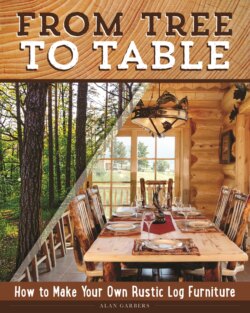Читать книгу From Tree to Table - Alan Garbers - Страница 13
На сайте Литреса книга снята с продажи.
Finding Logs
ОглавлениеSometimes finding logs is the hardest part. Sure, it may be easy to find logs in general, but what if you want to make a red cedar bed? Or a hickory bed? Or a sassafras bed? Or an aspen bed? You get the idea. And, since most builders want their products to be symmetrical—meaning the legs to be close to the same diameter and shape—it will take more trees than you can imagine to make one bed. If you don’t own property with a good selection of trees, you’re in trouble.
There are ways to find logs, if you’re enterprising:
✓ The first way to find logs is to know someone that has lots of land with a huge selection of trees. Generally, if you ask politely and explain what you’re working on, they will allow you to cut a few trees. Now, you might need to resort to a little bribery. In the past, I have been known to offer to make a piece of log furniture in exchange for access to their trees. No one can resist a free table or headboard from trees cut from their own woods. One such trade netted me truckload after truckload of logs.
✓ Some farmers may want their fence line cleared. After all, trees shade crops and reduce their production. The same farmer may want an overgrown pasture thinned. Cows don’t eat trees and grass doesn’t grow in the shade. Some tree leaves (black cherry) can actually poison livestock. Be sure to pile all the “slash” neatly and out of the way. (Slash is logger talk for the branches and undesirable cuts of wood nobody wants.)
✓ Anyone that has a tree farm has a running battle of TSI. That’s forester talk for Timber Stand Improvement. If someone is managing their forest for valuable hardwoods, they need to remove the undesirable trees regularly so that the valuable saplings and young trees get plenty of sunlight and nutrients. It is a hard job and rarely ever as complete as it should be. Fast-growing trees like sassafras, locust, yellowwood, and other species can quickly outpace a white oak, walnut, or black cherry. If left to grow wild, the more valuable but slower-growing trees will get shaded out and die off, leaving a thick stand of junk wood. Work with a forester or landowner to perform TSI and you will get more logs than you can ever use. Just remember to not drive over, walk on, or drop trees on the valuable trees. The good thing is that you usually don’t need to do anything with the slash. The idea is to let nature do its thing and put the nutrients back into the ground as the slash rots. Another positive is that the slash provides good cover for birds and animals hiding from predators.
✓ Often, state and federal forest managers offer a firewood-cutting permit or fence post permit. For a small fee the rules are fairly simple; cut your wood in a specified area directed by the manager or don’t cut more than your permit allows.
✓ Speaking of fence posts, sometimes farmers and ranchers want to clear out or replace old fences. In many cases, they use a bulldozer to shove the posts and fence wire into a huge pile. It can take some sweat and hard work to separate them, but some of those old posts are beautifully weathered with decades of distressing that gives each one unique character.
✓ Some homeowners want trees thinned or removed from their yard. Unless the trees are small and manageable, I would stay away from such things because it doesn’t take much to drop a tree in an unexpected direction and flatten a car or house.
Advertising on social media or community sites is a great way to get the word out that you’re looking for logs. Even if you don’t get enough logs to finish a project, keep the logs and set them aside for a later date when you have access to more.
